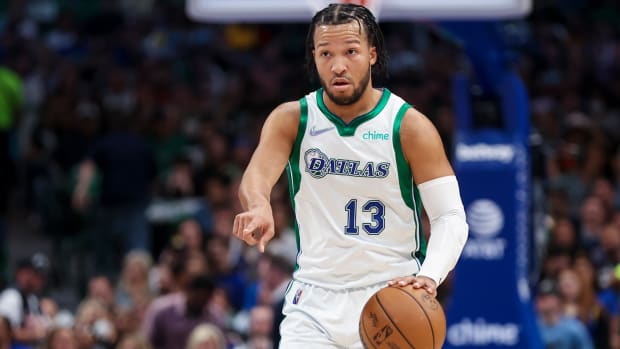Relatively speaking, it’s already been a week of milestones for the Knicks.
Aside from the fact that they acquired a healthy, solid, starting-caliber point guard for the first time in a decade—and even longer ago if you want to find one who was in his prime—New York used its early free-agent funds to re-sign one of its former draft picks on a multi-year deal; something it hadn’t done since striking a deal with Charlie Ward way back in 1999.
But for all the trivia that’s emerging from the Knicks’ spending spree, there’s a more basic question at play: Are the team’s moves—snagging Jalen Brunson for four years and $104 million, bringing in backup big Isaiah Hartenstein, and re-inking Mitchell Robinson—a step toward making them a playoff team again in 2023?
Answering that is challenging, and probably requires seeing what else the team can pull off in the coming weeks and months; particularly on the trade market.
The truth is, the moves themselves are fine. Some will knock Brunson’s $26 million per year price tag, saying it’s ludicrous to pay that for an undersized player who’s had the benefit of backing up and playing alongside a perennial MVP candidate in Mavericks star Luka Dončić.

Kevin Jairaj/USA TODAY Sports
For all the focus of how much the Knicks spent on their new ball-handler, it’s useful to point out that Brunson is now the 14th-highest paid point guard in the league; meaning he’s essentially right in the middle among starters. Additionally, the league’s salary cap figures to be considerably high in the coming years, with the NBA seeking a new TV rights deal worth tens of billions. Assuming that happens, contracts like Brunson’s will eat a smaller share of the cap.
In light of that, the $26 million figure doesn’t seem like a wild overpay for someone who can score and get his own shot the way Brunson can. Even without Dončić for the first few games of a series with Utah, Brunson diced the Jazz—and rim protector extraordinaire Rudy Gobert to the tune of 32 points and 5.3 assists per game while shooting better than 50% from the field. (He also shot 41.2% from distance over that initial three-game span without Dončić.)
Even at 6-foot-1, the guard is comfortable in traffic, and unusually efficient from inside the arc, among the trees. He’s connected on more than half his two-point attempts for all four years of his NBA career, and, amazingly, has shot almost 72% from inside of three feet for his career. He’s regularly near the top of the league among wings when it comes to finishing at the rim. While he isn’t the lob passer that Dončić is (it’s hard to find anyone who is), players like the athletic Robinson and the talented Hartenstein will find themselves with far more opportunities for alley-oops with Brunson than they would have gotten from the Knicks’ other guards.
Yet the question of performing in traffic becomes far more relevant when talking about the Knicks, who lack spacing, and, as such, were one of the NBA’s five worst clubs in terms of field-goal percentage at the rim last year. Will Brunson—a player who enjoyed far more space with the Mavs’ four- and sometimes five-out lineups—be able to probe the gaps in New York?
He’s not someone who gets to the line at an enormous clip, so the Knicks likely won’t be able to rely on him generating a bunch of points that way. He also isn’t someone who pulls the trigger all that much, or that well, in pull-up three scenarios; perhaps because he was often able to play off the ball with Doncic, and was more comfortable as a catch-and-shoot threat.
Making sense of Brunson’s fit in New York would be easier if we knew Tom Thibodeau’s preference in terms of his starting lineup and if we knew what the final roster would look like.
Should Brunson start alongside someone like Evan Fournier, it’s easy to imagine the Knicks’ backcourt struggling to get defensive stops. Second-year wing Quentin Grimes, on the other hand, would be more physical on that end while still providing the needed spacing along the perimeter.
In a nutshell, if these moves are all that’s to come for a while, they may not ultimately move the Knicks’ ceiling all that much. They could end up a win-loss improvement of a few games, and have a more efficient offense, with far better play from their starting point guard. But the real question is what other moves, if any, are on the way?
New York still owns a pile of future picks—nine first-rounders in the next five drafts, to be exact—and could push its chips in the middle of the table for a disenchanted star at some point in an effort to make the next step. Perhaps the Knicks could swing another deal, like potentially moving veteran guard Derrick Rose, to loosen their lead-guard rotation some. Maybe they find a taker for 27-year-old forward Julius Randle, who’s coming off a down year, to free up more ball-handling opportunities for 22-year-old RJ Barrett.
They’re all hypotheticals for now. But the Brunson move—and the flurry of second-rounders New York moved to make it possible—only qualifies as a game-changer if it's a precursor to something else. And until we see what that is, exactly, it’s difficult to put the Knicks’ offseason in the winner column or the loser one. The team is still a work in progress; one that Brunson helps them with, but clearly doesn’t complete on his own.
Watch the Knicks all season long with fuboTV: Start a 7-day trial today!







